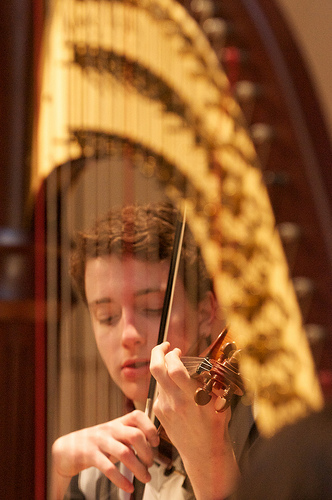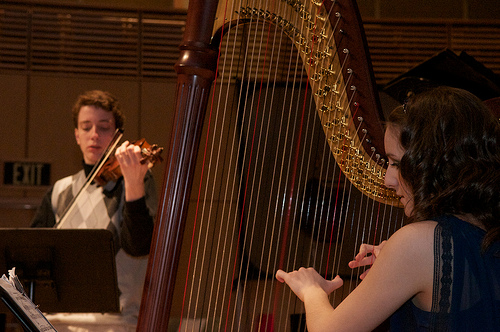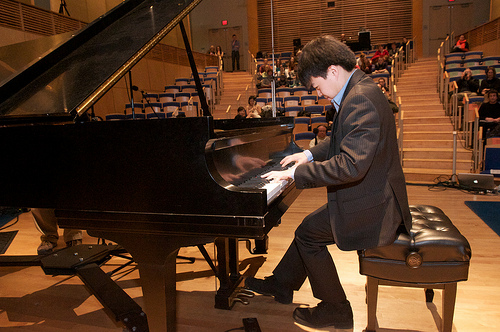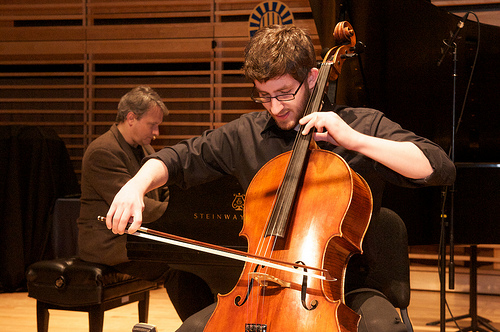247: Listening Guide
From the Top’s broadcast for Show 247 was taped in the Studzinski Recital Hall at Bowdoin College in Brunswick, Maine on Wednesday, February 29, 2012. We asked our performers to tell us about the music they performed on the show:
Gloria Ferry-Brennan, violin, 15
I. Allegro con fuoco from Violin Sonata, Op. 119
By: Francis Poulenc
This piece with its rhythmic complexity and disjointed melodies is both angry and sad in nature. This moody quality expresses Poulenc’s feelings surrounding the execution of the poet Garcia Lorca during the Spanish Civil War. Playing this sonata sets me free to express those difficult emotions as well.
I like the way Poulenc explores feelings about death in unexpected and unfamiliar ways. He makes some passages, such as the opening theme, “tres violent” and others he marks “tres doux”, alternating urgently back and forth. It is this tension and release that I look for in the music.
Post Show Reflection: I loved meeting the awesome kids and the inspirational staff. I felt like I learned more about myself and what I can do to make a difference in the world through my music. The performance felt great! It was a wonderful experience to talk as well as perform in front of an audience.
Music can change people’s lives and heal.
Moon Sun Yoo, clarinet, 17
Introduction, Theme and Variations
By: Gioacchino Rossini
The piece that I will be performing is Introduction, Theme, and Variations by Rossini. This piece is one of my favorite pieces because whenever I play this piece I feel like I’m flying in the sky. The introduction (very first part) gives me an image of a fat tenor singing his part in the opera. This is my favorite part because even though I’m a short little girl, I feel like I’ve just become such a different person, like a tenor! The least favorite part is the very last part, Maggiore. I’ve made a lot of mistakes on this part in my past.
I think this piece is unique because it has this simple and humorous “ theme” and as the variations go on to the end, it gets very faster which makes the piece much joyful and various. The most challenging parts of this piece are the passages that ask players to play extremely fast, while the fingering are so difficult. It is also hard to stay musical while playing those different passages.
Post Show Reflections: The performance was great!Before I go on a stage, I am always a little nervous but when I actually performed, I just concentrated on my playing. The interview was fun too!!My favorite memory was the Arts Leadership Orientation. It was a great experience to think about myself as a musician.
Music has the ability to change and move people’s lives.
Elan Duo
(Stephanie Curcio, coach)
Prelude from Suite Bergamasque
By: Claude Debussy
Nash Ryder, violin, 16
I am a fan of all things French, especially the music; what composer is more quintessentially French than Debussy? When Anna and I play his Preludetogether, I imagine and feel like I am in a Paris café or in the forest of Fontainebleau.
The Prelude is from the popular Suite Bergamasque, written by Debussy for solo piano, but I think the piece has a more delicate French-like quality when played by the violin and harp. It’s a pleasure to play this piece and every time we do something new and more interesting seems to come through, both in the color and texture of the music and the feelings and images it invokes.
French music, like the culture and the people of France, tends to be more understated and gentle compared to the gusto of Spanish or German music….that is not to say it can’t be exciting or just as brilliant. The Preludehas incredible color and its melodies and harmonies paint a very vivid picture in my mind. Anna and I try to express this color and vivid picture in the audience’s mind with the script Debussy gives, and it has definitely taken time to interpret and deliver. We love playing this piece!
Post-Show Reflection: Playing on the show was incredible, and I’ll always be thankful for the opportunity to be a part of it. I’m very thankful for all the great work and support from the FTT organizers, staff, and Chris O’Riley. Also, it was really cool hanging out with the other performers till the early hours of the morning.
Music has the ability to change lives and communities, as long as the arts leaders are passionate.
Anna DeLoi, harp, 16
Do you know that amazing, inexplicable feeling you get when you listen to a piece of music and it seems to be written just for you? That’s what I felt the first time I listened to the Prelude from Suite Bergamasque. I know it’s a crazy idea that I can find something so personal in something that was created one hundred years ago, but I think that’s Debussy’s secret right there – he knows how to write about the things we all have in common, the parts of human nature we can’t even fully understand. Therefore, unlike with many pieces I’ve played, I don’t connect this Prelude to a picture or a story, but to an emotion.
To me, this piece sounds like hope; like starting something new, a little bit scared of the unknown, but filled with wonderful possibilities. In my life, that translates to the feeling of being an adolescent – this turning point when everything is suddenly scary, but it’s also going to be one of the most exciting times in my life! I hope that when you listen to Nash and me perform it, you’ll hear something entirely different – but that it will fell just as personal as it does to me.
This piece is really unique to play, for a couple of reasons. For one, it was originally a piano piece. Nash and I had to figure out how to translate that to our instruments – working on colors, and balancing the lines that are divided between us. But in spite of that, it has always been one of our favorite pieces to perform. Because weirdly, even the first few times we played it together, we never had to work very much on synching our interpretations or timing the rubato. For some reason, we just seemed to feel the music the same way – which is such an awesome feeling! I think that music, especially chamber music, is always more fun when you don’t have to overthink it.
Post Show Reflections: A favorite memory for me was the atmosphere in the green room during the show – we had all bonded before then, and it felt like being with old friends as each of us went out to perform. We cheered for each other and gave encouragement. It was just so positive back there! It’s always a little scary to walk on stage for a performance, but in Studzinski. I could really feel the support of the audience and everyone backstage. It made me want to give them the absolute BEST performance I could.
I think that music has the power to express the feelings and stories of the people who listen to it, even when those people come from completely different places and backgrounds. I think that’s what makes it so powerful.
Allen Yu, piano, 19
“The Great Gate of Kiev” from Pictures at an Exhibition
By: Modest Mussorgsky
“The Great Gate of Kiev” is the last piece in Mussorgsky’s Pictures at an Exhibition, which Mussorgsky composed in honor of his friend, the artist Viktor Hartmann. Hartmann died from an aneurysm at the young age of 39, and his death shocked many great artists, including the critic Vladimir Stasov. As a memorial, Stasov set up an exhibition of Hartmann’s greatest works in St. Petersburg. Mussorgsky attended this exhibition and was so deeply inspired by the experience that he proceeded to complete Pictures at an Exhibition in only six weeks. The piece depicts eleven of Hartmann’s works, of which only six have survived until now, including “The Great Gate of Kiev” (or “The Bogatyr Gates”).
This piece really is the climax of the suite – it is full of the signature grandiosity and majesty so prevalent in Russian music. The movement starts with the grand chords of the main “Maestoso” theme, but then it goes to a solemn Orthodox baptismal hymn. Although it’s so easy to be engrossed by the opening chords, I think the most beautiful parts of this movement are the secondary themes in between the main one. Kiev is the birthplace of the Orthodox Church in Russia, and the hymn not only gives the audience (and me) a chance to breathe, but it also foreshadows the ringing of the church bells when the “Promenade” theme (the signature theme of the entire suite) returns. The entire piece is very orchestral and it is the perfect piece to orchestrate.
Playing the entire suite is challenging in many ways, but the hardest thing about playing just this movement is that in a few seconds before playing the opening chords, I would need to produce the same energy and momentum as if I had played every movement that came before it. The movement before, “Baba-Yaga’s Hut,” is a perfect prelude to “Kiev” because it builds up the momentum with the big octave passage right before the opening of “Kiev”. It’s very easy to play the opening chords of “Kiev” as simple and isolated chords, but actually the chords are really the resolution to all the tension that was built up in “Baba-Yaga” and the movements that came before it. Playing just this movement means I’ll need to be extra concentrated before the start of the piece.
Even though Pictures was originally written for piano, the one most people recognize now is Ravel’s orchestration of the suite. I think this piece really sounds better in Ravel’s arrangement because the piano simply cannot compete with the sounds that the brass section can produce or the various colors that the percussion instruments can make. Playing this movement on the piano is particularly challenging because I needed to assume the role of so many different instruments. At one performance of this piece last year, I got really excited that I may have broken a string on the piano playing the last few chords of the piece. However, the chords ended up having a peculiar “ringing” tone that sounded like a cross between tubular bells and a triangle – I actually really liked it!
Pictures was one of the favorite pieces of the Russian pianist Vladimir Horowitz. There had been many transcriptions and orchestrations of Pictures in existence by the late 20th century, and Horowitz took many of those editions and arranged it back into a piano version that he believed gave more orchestral colors to the music. The version I will be playing on air is a mix between the original Mussorgsky, Horowitz’s arrangement, and parts that I arranged myself.
Post Show Reflections: Other than sheer excitement of being back on the stage of From the Top, my favorite memories came from bonding with everyone on the show – it’s always the best part of being on FTT. As soon as I sat down on that bench on stage to play, the anxiety I was feeling became the energy that helped me make a memorable performance.
Music has the potential to unite and cross barriers no other activity can.
Ben Manis, cello, 17
III. Andante from Sonata in G minor for Cello and Piano, Op.19
By: Sergei Rachmaninoff
This theme of this work is about love, I guess; not romantic, but a kind of deep compassion and sensitivity. At the beginning, it’s all about yearning, pushing forward, until we get to the massive release, and then it’s all perfect and wonderful. I don’t think of anything specific, just big, broad emotions.
The technique in this work is all about smoothness. The crescendo through the first half of the piece has to be absolutely smooth and continuous, so when we get to the climax we feel like we don’t even know how we got there. You gotta nail the long lines and the transitions between the phrases, like a painter painting with a perfectly stretched arm.
Post Show Reflection: A favorite moment for me was listening to the banter between Tom and Tim. Those guys are awesome. The performance itself was awesome – great sound, great audience…fun.
Music can do…anything? It’s not really the music, it’s the people playing it.









